| author | Sang-Hee Shim and Minhaeng Cho |
|---|---|
| journal | Chemical Science (DOI: 10.1039/c8sc03558j) |
| Homepage | https://cmsd.ibs.re.kr/html/cmsd_en/ |

Euihyun Lee(이의현, 박사과정, 제1저자)
Fluorescent proteins contain an internal chromophore constituted of amino acids or an external chromophore
covalently bonded to the protein. To increase their fluorescence intensities, many research groups have
attempted to mutate amino acids within or near the chromophore. Recently, a new type of fluorescent
protein, called UnaG, in which the ligand binds to the protein through many noncovalent interactions was
discovered. Later, a series of mutants of the UnaG protein were introduced, which include eUnaG with
valine 2 mutated to leucine emitting significantly stronger fluorescence than the wild type and V2T mutant,
in which valine 2 is mutated to threonine, emitting weaker fluorescence than the wild type. Interestingly,
the single mutation sites of both eUnaG and V2T mutants are distant from the fluorophore, bilirubin, which
renders the mechanism of such fluorescence enhancement or reduction unclear. To elucidate the origin of
fluorescence intensity changes induced by the single mutations, we carried out extensive analyses on MD
simulations for the original UnaG, eUnaG and V2T, and found that the bilirubin ligand bound to eUnaG is
conformationally more rigid than the wild-type, particularly in the skeletal dihedral angles, possibly resulting
in the increase of quantum yield through a reduction of non-radiative decay. On the other hand, the
bilirubin bound to the V2T appears to be flexible than that in the UnaG. Furthermore, examining the
structural correlations between the ligand and proteins, we found evidence that the bilirubin ligand is
encapsulated in different environments composed of protein residues and water molecules that increase or
decrease the stability of the ligand. The changed protein stability affects the mobility and confinement of
water molecules captured between bilirubin and the protein. Since the flexible ligand contains multiple
hydrogen bond (H-bond) donors and acceptors, the H-bonding structure and dynamics of bound water
molecules are highly correlated with the rigidity of the bound ligand. Our results suggest that, to
understand the fluorescence properties of protein mutants, especially the ones with noncovalently bound
fluorophores with internal rotations, the interaction network among protein residues, ligand, and water
molecules within the binding cavity should be investigated rather than focusing on the local structure near
the fluorescing moiety. Our in-depth simulation study may offer a foundation for the design principles for
engineering this new class of fluorescent proteins.
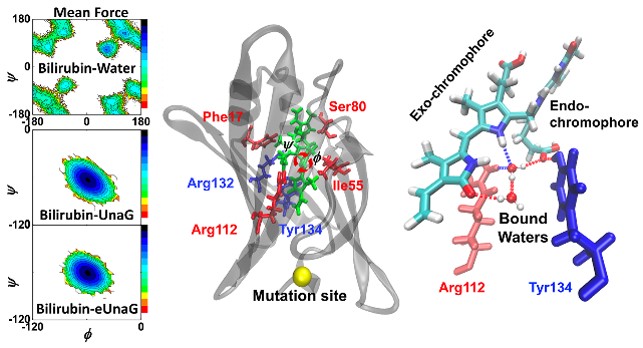
This article is part of the themed collection: 2018 Chemical Science HOT Article Collection
https://pubs.rsc.org/en/Content/ArticleLanding/2018/SC/C8SC03558J#!divAbstract
-
Read More
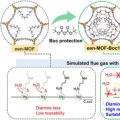
Boc Protection for Diamine-Appended MOF Adsorbents to Enhance CO2 Recyclability under Realistic Humid Conditions
Among the various metal–organic framework (MOF) adsorbents, diamine-functionalized Mg2(dobpdc) (dobpdc4– = 4,4-dioxidobiphenyl-3,3′-dicarboxylate) shows remarkable carbon dioxide removal performance. However, applying diam... -
Read More

Double-Walled Tubular Heusler-Type Platinum–Ruthenium Phosphide as All-pH Hydrogen Evolution Reaction Catalyst Outperforming Platinum and Ruthenium
Nanostructured ionic compounds have driven major technological advancements in displays, photovoltaics, and catalysis. Current research focuses on refining the chemical composition of such compounds. In this study, a strategy for creating s... -
Read More

Seebeck Effect in Molecular Wires Facilitating Long-Range Transport
The study of molecular wires facilitating long-range charge transport is of fundamental interest for the development of various technologies in (bio)organic and molecular electronics. Defining the nature of long-range charge transport is ch... -
Read More
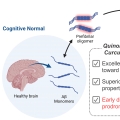
Early onset diagnosis in Alzheimer’s disease patients via amyloid-β oligomers-sensing probe in cerebrospinal fluid
Amyloid-β (Aβ) oligomers are implicated in the onset of Alzheimer’s disease (AD). Herein, quinoline-derived half-curcumin-dioxaborine (Q-OB) fluorescent probe was designed for detecting Aβ oligomers by finely tailoring ... -
Read More
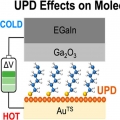
Thermopower in Underpotential Deposition-Based Molecular Junctions
Underpotential deposition (UPD) is an intriguing means for tailoring the interfacial electronic structure of an adsorbate at a substrate. Here we investigate the impact of UPD on thermoelectricity occurring in molecular tunnel junctions bas... -
Read More
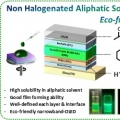
Eco-friendly solution-processed narrowband OLEDs using non-halogenated aliphatic solvent systems
In general, fabricating multilayer structures in solution-processed organic light-emitting diodes (OLEDs) presents challenges owing to the potential degradation of the initial film during subsequent processing steps. Furthermore, these devi... -
Read More
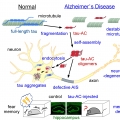
Self-Aggregating Tau Fragments Recapitulate Pathologic Phenotypes and Neurotoxicity of Alzheimer's Disease in Mice
In tauopathy conditions, such as Alzheimer's disease (AD), highly soluble and natively unfolded tau polymerizes into an insoluble filament; however, the mechanistic details of this process remain unclear. In the brains of AD patients, o... -
Read More

Ultranarrow Mid-infrared Quantum Plasmon Resonance of Self-doped Silver Selenide Nanocrystal
The infrared quantum plasmon resonance (IR QPR) of nanocrystals (NCs) exhibits the combined properties of classical and quantum mechanics, potentially enabling unprecedented optics. However, research on the development of localized surface ... -
Read More
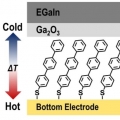
Molecular Thermoelectricity in EGaIn-Based Molecular Junctions
Understanding the thermoelectric effects that convert energy between heat and electricity on a molecular scale is of great interest to the nanoscience community. As electronic devices continue to be miniaturized to nanometer scales, thermor... -
Read More
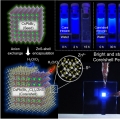
Perovskite Nanocrystals Protected by Hermetically Sealing for Highly Bright and Stable Deep-Blue Light-Emitting Diodes
Metal–halide perovskite nanocrystals (NCs) have emerged as suitablelight-emitting materials for light-emitting diodes (LEDs) and other practicalapplications. However, LEDs with perovskite NCs undergoenvironment-induced and ion-migratio... -
Read More
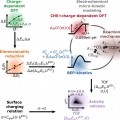
The importance of a charge transfer descriptor for screening potential CO2 reduction electrocatalysts
It has been over twenty years since the linear scaling of reaction intermediate adsorption energies started to coin the fields of heterogeneous and electrocatalysis as a blessing and a curse at the same time. It has established the possibili... -
Read More
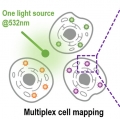
Resonant Raman-Active Polymer Dot Barcodes for Multiplex Cell Mapping
Resonance Raman spectroscopy is an efficient tool for multiplex imaging because of the narrow bandwidth of the electronically enhanced vibrational signals. However, Raman signals are often overwhelmed by concurrent fluorescence. In this stud... -
Read More
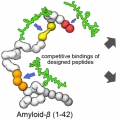
Decoding the Roles of Amyloid-β (1-42)'s Key Oligomerization Domains toward Designing Epitope-Specific Aggregation Inhibitors
Fibrillar amyloid aggregates are the pathological hallmarks of multiple neurodegenerative diseases. The amyloid-β (1-42) protein, in particular, is a major component of senile plaques in the brains of patients with Alzheimer’s di... -
Read More

Flattening bent Janus nanodiscs expands lattice parameters
Nanoscale lattice parameter engineering is a potentially powerful tool for tailoring the electronic properties of nanomaterials. The nascent strain in juxtaposed hetero-interfaces of nanocrystals was recently shown to substantially affect t... -
Read More
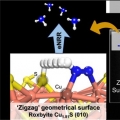
Directing the surface atomic geometry on copper sulfide for enhanced electrochemical nitrogen reduction
Understanding catalytic-conversion determinants will blueprint an efficient electrocatalyst design for electrochemical nitrogen reduction. In metal chalcogenide-based catalysts, metal-site nitrogen adsorption initiates nitrogen fixation, an... -
Read More
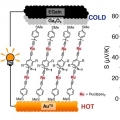
High Seebeck Coefficient Achieved by Multinuclear Organometallic Molecular Junctions
This paper describes thermoelectric property of molecular junctions incorporating multinuclear ruthenium alkynyl complexes that comprise Ru(dppe)2 (dppe = 1,2-bis(diphenylphosphino)ethane) fragments and diethylnyl aromatic bridging ligands ... -
Read More
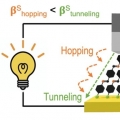
Thermopower in Transition from Tunneling to Hopping
The Seebeck effect of molecular junction in a hopping regime or tunneling-to-hopping transition remains uncertain. This paper describes the Seebeck effect in molecular epitaxy films (OPIn where n = 1 – 9) based on imine condensation b... -
Read More
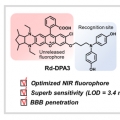
An Activity-Based Fluorescent Probe for Imaging Fluctuations of Peroxynitrite (ONOO-) in the Alzheimer's Disease Brain
Peroxynitrite (ONOO-) plays a critical role in Alzheimer's disease (AD), and the association between ONOO- and AD is inexplicit. To reveal the ONOO- influxes in AD brains, an activatable activity-based fluorescence probe Rd-DPA3 was rat... -
Read More

Deep learning for development of organic optoelectronic devices: Efficient prescreening of hosts and emitters in deep-blue fluorescent OLEDs
The highest occupied molecular orbital (HOMO) and lowest unoccupied molecular orbital (LUMO) energies, which are key factors in optoelectronic devices, must be accurately estimated for newly designed materials. Here, we developed a deep lea... -
Read More
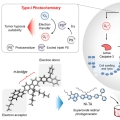
Photocatalytic Superoxide Radical Generator that Induces Pyroptosis in Cancer Cells
In this study, we show that a photocatalytic superoxide radical (O2−•) generator, NI-TA, triggers pyroptosis in cancer cells. NI-TA was designed to take advantage of an intramolecular triplet-ground state splitting energy modulat...

